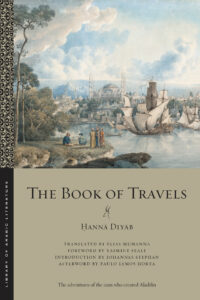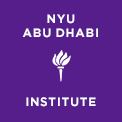In this guest post, Matthew Chovanec explores how The Book of Travels by Ḥannā Diyāb, translated by Elias Muhanna, relates to modern world travel and disenchantment.
 Reading old travelogues would be more enjoyable if it wasn’t also a reminder of how thoroughly unenchanted travel has become in the modern world. What Ḥannā Diyāb describes as an epic, year-long journey across an entire continent in his account The Book of Travels can these days be done in four hours on a cheap flight from Paris to Beirut. Rather than hear the source material for some of the most famous tales in the Thousand and One Nights from a native informant as Antoine Galland did from Diyāb, now you can stream the new live-action Aladdin while sitting in economy class. And rather than risk the shipwrecks and lice and deadly winter storms that Diyāb endured on his trip to France, the most bodily harm you are likely to risk nowadays is a crick in the neck from trying to sleep on the plane.
Reading old travelogues would be more enjoyable if it wasn’t also a reminder of how thoroughly unenchanted travel has become in the modern world. What Ḥannā Diyāb describes as an epic, year-long journey across an entire continent in his account The Book of Travels can these days be done in four hours on a cheap flight from Paris to Beirut. Rather than hear the source material for some of the most famous tales in the Thousand and One Nights from a native informant as Antoine Galland did from Diyāb, now you can stream the new live-action Aladdin while sitting in economy class. And rather than risk the shipwrecks and lice and deadly winter storms that Diyāb endured on his trip to France, the most bodily harm you are likely to risk nowadays is a crick in the neck from trying to sleep on the plane.
One particular moment in Diyāb’s travelogue shows not only that the world has become unenchanted but also how he himself contributed to this change. Once he arrives in France, Diyāb is granted an audience with King Louis XIV. At the palace in Versailles, he and his travel companion Paul Lucas present a number of curios to the court, including a strange looking rodent with large ears never before seen in Europe.
The King and all his nobles turned to face me. Someone asked what the animals were called. I replied that, in the lands where it is found, the animal is called a Jarbu’. Then the king ordered his attendants to give me a pen and paper so that I could write the name down in my language.
Here we have the precise moment when the jerboa (Allactaga tetradactyla) is introduced to western science. In introducing the jerboa to the French court, Diyāb is not merely showing off curiosities: he is contributing to the expansion of scientific knowledge. European scientists would go on to study, categorize, and ultimately demystify this remarkable creature and give it a cold-sounding and precise Latin name. If the “fate of our times is characterized by rationalization and intellectualization and, above all, by the disenchantment of the world” as Max Weber famously claims, then Diyāb is himself implicated for having introduced an exotic desert-dwelling mouse to those who would ultimately catalog it.
But should we be so hard on Diyāb? There has been a lot of recent conversation devoted to debating the ambiguous relationship between seemingly cold scientific knowledge and the intimate connection we have with the natural world. Does the naming and taxonomizing of plants and animals contribute to their domination and exploitation, or can it also serve as a way of maintaining wonder, curiosity, and connection with the living world? As the ecological scientist Robin Wall Kimmerer puts it in Braiding Sweetgrass, “Science can be a way of forming intimacy and respect with other species that is rivaled only by the observations of traditional knowledge holders. It can be a path to kinship.” Sometimes, learning more about the life cycle or ecosystem of a species can lead us to more deeply appreciate and empathize with the living world. It can also make travel and exploration exciting again, by reintroducing us to the uniqueness of each place. Science, it turns out, can make travel enchanting again.
 But how exactly is learning the Latin name of some random plant meant to be enlightening? In her book How to Do Nothing, Jenny O’Dell explains how, whenever she travels, she brings along her phone which has an app for identifying species called iNaturalist. You take a picture of a mysterious plant (or long-eared rodent), and the app uses visual recognition software to immediately identify and name the species for you. Take a picture of a bush by the side of the road and all of a sudden you’ll have its Latin name, and with it access to all our scientific knowledge about it. You can learn about the type of soil it likes, how drought tolerant it is, and whether it was traditionally used by locals for medicinal purposes. With just a little bit of context, an anonymous weed becomes a central player in an ecology and a culture. While familiarizing yourself in this way may represent an itemizing, scientific view of nature, O’Dell also claims that it serves the “first step in perceiving not just ‘land’ or ‘greenery,’ but living bodies instead.”
But how exactly is learning the Latin name of some random plant meant to be enlightening? In her book How to Do Nothing, Jenny O’Dell explains how, whenever she travels, she brings along her phone which has an app for identifying species called iNaturalist. You take a picture of a mysterious plant (or long-eared rodent), and the app uses visual recognition software to immediately identify and name the species for you. Take a picture of a bush by the side of the road and all of a sudden you’ll have its Latin name, and with it access to all our scientific knowledge about it. You can learn about the type of soil it likes, how drought tolerant it is, and whether it was traditionally used by locals for medicinal purposes. With just a little bit of context, an anonymous weed becomes a central player in an ecology and a culture. While familiarizing yourself in this way may represent an itemizing, scientific view of nature, O’Dell also claims that it serves the “first step in perceiving not just ‘land’ or ‘greenery,’ but living bodies instead.”
And so while here in the twenty-first century scientific knowledge has built a world which removes us from our natural connection to ecosystems by herding us all into those anonymous, transient places known derisively as non-places, at the same time grants us immediate access to encyclopedic information about a plant with a simple snap of a photo. It has made world travel mundane, but also can give us the opportunity to discover and explore in ways never imaginable to someone like Ḥannā Diyāb.

Verbena bracteata (Wikimedia Commons)
I myself often travel to Middle Eastern cities for work but between the airport, the hotel, and meetings, I rarely find time for any sightseeing. It is precisely this type of travel which makes me wistful for the rustic era in which Diyāb traveled. But even when my itinerary is restricted to non-places, I always manage to snap a few photos of plants. Even if just from the taxi window or while walking down a street, I am on the lookout for any weed or shrub to take a picture of, so that I can upload it to iNaturalist. Once I do, I am reminded immediately that I am in fact halfway across the world. Even if hotel rooms and airport terminals look the same everywhere, when I can identify a particular plant, an abandoned lot suddenly becomes a Mediterranean hillside (Hirschfeldia incana), the Anatolian steppe (Alyssum hirsutum) or a salt flat in the Gulf (Verbena bracteata).
In this way, plants serve as a direct link between the travel that someone like Ḥannā Diyāb once endured, and someone like me who takes travel for granted. The knowledge he imparted to others has traveled down through the centuries in the names of plants and animals to me, as I return to the same places he once visited. Centuries apart, we both kill time looking for the same plants on the same hillsides. As he recounts in an earlier episode while still back in Lebanon,
We spent the rest of the day in al-Zuq. The next morning, we bid farewell to the chevalier and journeyed through the mountains, from village to village, as the Khawajah foraged for plants.
How enchanting is that?
—
Matthew Chovanec is an independent researcher who received his PhD in Arabic and Turkish literature from the University of Texas at Austin. His research interests include materialist ecology, digital culture, and linguistic narratology. He is also the translator from the Turkish of The Mosquito Bite Author by Barış Bıçakçı and Gavur Mahalessi by Mıgırdiç Margosyan.

